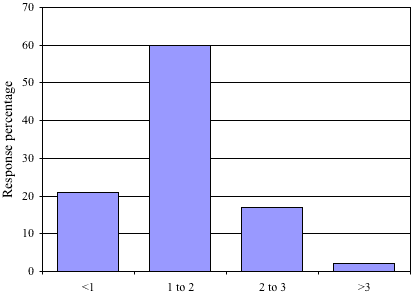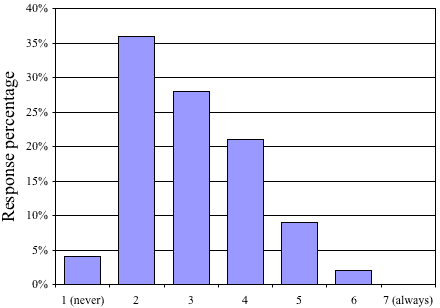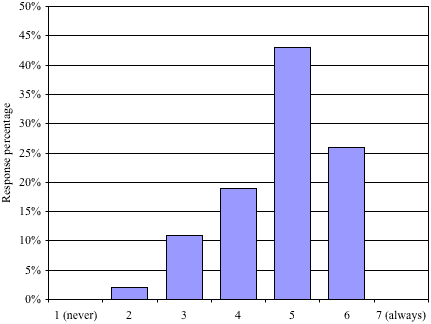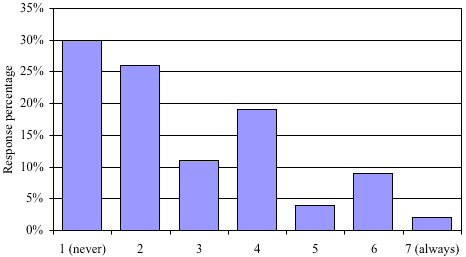June 2004 // Volume 42 // Number 3 // Research in Brief // 3RIB3
E-Mail Use and Communication Perceptions of University of Vermont Extension Employees
Abstract
A study was conducted concerning how University of Vermont Extension
employees used and perceived electronic mail as an intra-organizational
communication tool. The results indicated that "broadcast" e-mail
was less likely to be responded to than personalized e-mail, e-mail
tone was considered generally more aggressive than telephone conversations,
and sent messages have often been misinterpreted. A high majority of
respondents reported that e-mail has made their work easier due to
more efficient use of time, increased productivity, and 24/7 access,
but that spam is an increasing problem leading to reduced employee
satisfaction with e-mail.
Introduction
University of Vermont (UVM) Extension adopted electronic mail (e-mail) for limited communication use in 1992 (K. Parker, personal communication, June 23, 2002). Since then, it has become an essential communication method for Extension across the United States.
Communication between individual employees, between supervisors and subordinates, among teams of employees, and between employees and customers all occur increasingly by way of e-mail. Listserves are common and are used on a daily basis by any one of UVM Extension's employees. Employees also have access to "Web mail" via the Internet from home or road.
Some research suggests that employees are better informed about their organization and more committed to management's goals because of e-mail (Kraut, 1997). However, the lack of interactivity that e-mail provides is perceived as introducing communication problems into the workplace, increasing the intensity of emotion in the workplace, and becoming a driver for intra-organizational conflict (Donahue, 1999).
E-mail excludes nonverbal cues available in face-to-face interaction and is incapable of creating tone, which may increase the potential for misinterpretation of messages (Donahue, 1999). Many people communicate emotions through facial expressions or tone of voice rather than in their words. While a supervisor may think he or she has communicated a directive clearly, the subordinate may be carrying out orders that were never intended or doing something quite different than the supervisor requested.
Other research indicates that e-mail is being used for functions for which it was not originally intended, including task management and personal archiving (Whittaker & Sidner, 1997). Users often have cluttered inboxes with outstanding tasks, partially read messages, and lost conversational threads.
There is evidence in the literature that women have adapted more readily to e-mail than men. For instance, in a case study on employees' attitudes toward e-mail, results revealed that women perceived e-mail to be easier to use, more efficient, and more effective than did males (Allen, 1995).
The study described here was conducted to better understand e-mail use patterns and perceptions about e-mail within UVM Extension. The skill with which managers communicate with employees and how employees communicate on a peer-to-peer basis affect Extension productivity, morale, and employee retention.
Methodology
Eighty surveys were sent via e-mail to 50 female employees selected randomly from a list of female UVM Extension employees and 30 male employees selected randomly from a list of male UVM Extension employees in October 2002. The organization has approximately 135 employees, and the 5:3 female-to-male ratio approximated organizational gender demographics. Employees were given 8 days to respond; no reminder was sent.
The survey asked for five self-reported variables:
- Gender (M, F)
- Age (<26, 26-35, 36-45, 46-55, >55)
- Number of e-mails received per day (<6, 6-10, 11-20, 21-30, >30)
- Hours spent per day writing or responding to e-mail (<1, 1-2, 2-3, >3)
- Supervise others (yes or no)
The survey then posed a series of 15 close-ended and two open-ended questions. The questions were created with the intent to flush out differences between self-reported categories, above, and e-mail use and perception as a means of communication within the organization. For instance, do people respond well to "broadcast" e-mail requests? Do employees with supervisory roles find e-mail less harsh than do those who do not supervise others? Are workers more likely to delete internal messages before reading them if they receive heavy volumes of e-mail? Has e-mail made the typical Extension employee's workday world easier or more difficult, and why?
Results were summarized and analyzed (one-way ANOVA [difference between group means], Chi-square tests [test for an association between two categorical values]) using Analyze-it™ software and MS Excel.
Self-Reported Results
Forty-seven usable surveys (58.75%) were returned. Of these, 14 were from males and 33 from females. Female response rate (70%) was greater than male response rate (30%). Females did not report more or less time spent per day or have a greater or lesser volume of e-mails than males. The majority (65%) of respondents were older than 35 years.
More than half of the respondents received more than 20 e-mails per day (Figure 1), and 60% of respondents said that they spent 1 to 2 hours writing or responding to e-mail per day (Figure 2). There was not a strong relationship between numbers received and time spent. Most (62%) of the "high use" (>30 per day) e-mailers spent 1 to 2 hours on e-mail, essentially the same proportion as the 11-20 and 21-30 groups. Two-thirds of the "low use" (<6 per day) e-mailers spent less than 1 hour on e-mail per day. No statistically significant differences were found between e-mails received per day or hours spent per day and gender or age.
Figure 1.
Number of E-Mail Messages Received per Day

Figure 2.
Hours Spent per Day on E-Mail

A slight minority (45%) reported that they supervised others. UVM Extension is characterized by a dispersed organizational structure with multiple supervisory layers that often overlap. It is common for one employee to have both a "functional" and "administrative" supervisor. A significant difference existed between supervisory status and number of e-mails received. Sixty-seven percent of supervisors reported that they received greater than 20 e-mails per day, compared to 38% of non-supervisors (p = 0.041).
Survey Questions and Results
A total of 17 questions were asked. Fifteen of these were closed-ended "yes-no," "more-less-same," or scaled questions, and two were open-ended questions to solicit additional comments. Responses to selected questions with findings of interest to Extension employees are found below. Results of all questions can be accessed via the Internet at http://www.geocities.com/emjoe3058.
Respond to Broadcast E-Mail?
1. Do you respond to e-mail requests from "broadcast" e-mails where you are one of many recipients?
This is the first of several questions where the respondent could choose a number between one (never) and seven (always).
The average response was 3.00 (Figure 3). The majority of respondents reported a low level of response to "broadcast" e-mail requests. No respondent said that they "always" responded to broadcast e-mail requests. There was no statistical difference between self-reported variables.
Figure 3.
Respond to Broadcast E-Mail?

Respond to Individually Tailored E-Mail?
2. Do you respond to e-mail requests when the e-mail is addressed to you specifically?
The average response was 6.26. The response rate for individually tailored e-mails (Figure 4) is much higher than for e-mails broadcast to multiple parties. Nearly half of the respondents said that they always respond. There was no statistical difference between self-reported variables.
Figure 4.
Respond to Individually Tailored E-Mail?

Has an E-Mail You Sent Ever Been Misinterpreted?
3. Has the meaning of an e-mail message you sent ever been misinterpreted?
The majority of respondents reported that their e-mails have been misinterpreted. Although not statistically significant, further analysis showed that 53% of non-supervisors reported affirmative, compared to 40% of supervisors.
Figure 5.
Has an E-Mail You Sent Ever Been Misinterpreted?

Is E-Mail More Aggressive in Tone?
4. Do you think people make more aggressive comments in an e-mail message than they would in a face-to-face meeting? Telephone call?
Forty-three percent of respondents said that people make more aggressive comments in e-mail than they would in a face-to-face conversation (Figure 6). There was no significant difference between genders. Fifty-four percent of non-supervisors found e-mail more aggressive than a face-to-face meeting, compared to 28% of supervisors (p = 0.202). Nearly half of those responding found e-mail comments more aggressive than a telephone call. There were no differences reported between self-reported categories.
Figure 6.
Is E-Mail More Aggressive in Tone Than . . .

Set Aside Sensitive E-Mail?
5. If you feel that the topic is sensitive or controversial, do you "set aside" the e-mail "to think about it" for a time prior to sending?
The majority of respondents reported setting aside e-mails of a sensitive nature (Figure 7). The average response was 5.21. "Low use" e-mailers (<6 e-mail messages received per day) reported that they were less likely to do so than other groups (p = 0.021).
Figure 7.
Set Aside Sensitive E-Mail?

Fewer or More Telephone Calls?
6. Since access to e-mail, do you have fewer or more telephone conversations?
The great majority reported fewer telephone conversations. There were no statistically significant differences between self-reported categories, including gender and supervisory status.
Figure 8.
Fewer or More Telephone Calls?

E-Mail Messages Relevant to Your Work?
7. Do you find that the e-mail messages you receive are relevant to your work?
The majority of respondents reported that their e-mail was generally relevant to their work (Figure 9). The average response was 4.79. Female respondents generally found their e-mail more relevant than did males (p = 0.118).
Figure 9.
E-Mail Messages Relevant to Your Work?

Delete Internal Mail Prior to Reading?
8. Do you delete internal e-mail messages before reading them?
Nearly one-third of respondents never delete internal e-mails prior to reading, while approximately 70% practice some level of "deletion behavior" (Figure 10). The average response was 2.92, with a high CV of 62%. There was a non-significant tendency for deletion rate to increase as usage increased, and for deletion rate of supervisors to be lower than that of non-supervisors.
Figure 10.
Delete Internal Mail Prior to Reading?

E-Mail Has Made Your Work . . .
9. Has e-mail made your work easier or more difficult?
Nearly three-quarters of respondents said that e-mail has made their work easier (Figure 11). There were no statistically significant differences between self-reported categories.
Figure 11.
E-Mail Has Made Your Work . . .

Open-Ended Questions
Two additional open-ended questions were posed--why e-mail made things easier or harder and an invitation to add anything the respondent wanted to about e-mail communication. Commonly reported positive comments about e-mail included:
- Fewer phone calls
- Appreciate the opportunity to respond to diverse issues
- Messages can be saved to form a "conversation"
- Ease of transferring files and information
- More efficient communication given conflicting schedules
- Cuts out phone chat
- Reach many people with same message--important for committee and team work
- Less travel
On the down side, a high proportion of respondents complained of spam. Also, some said that expectations of "instant" responses are troublesome.
Some reported a strong benefit of e-mail was 24/7 access, while others reported that was precisely what made life harder.
Discussion
The majority of respondents felt that e-mail made their Extension work easier. Research has shown that e-mail works well to coordinate conflicting work schedules (Dimmick, Kline, & Stafford, 2001). This is borne out by reasons that UVM Extension employees gave to explain why e-mail has made their work life easier--e-mail cuts out telephone tag and can be accessed at any time a computer and connection are available.
Approximately half of the respondents found e-mail to be more aggressive and harsher than face-to-face or phone conversations. This agrees with research that shows that the telephone is superior in expressions of caring and giving advice (Harper, 2002). The use of telephones has decreased dramatically for respondents. This reflects results of a study that reported that 48% of respondents stated using the phone less since they adopted e-mail (Dimmick, et al., 2001). Women respondents generally found e-mail in their inboxes more relevant to their work than men did.
Most people can "keep track" of their e-mails well. A small percentage, approximately 20%, rated their loss rate fairly close to "always," while 77% of respondents reported something less perfect than "never." Even though deleting before reading intra-organizational e-mails exists at a low level within the organization, it should be a consideration for those individuals who send a lot of e-mail--particularly broadcast e-mails.
Extension employees must be aware of the organizational implications and limitations of e-mail use. While a powerful tool for sending information and for efficient intra-organizational communication, e-mail must be used with caution, particularly from a management perspective. E-mail negatives include the inability to communicate tone, which appears to be more aggressive or harsh from a subordinate perspective; the higher likelihood of e-mail misinterpretation; and the increasing probability of messages being marginalized as the target audience becomes larger. Additionally, an organizational approach to spam control is needed to maintain e-mail utility.
References
Allen, B. J. (1995). Gender and computer-mediated communication. Sex Roles, 32, 7-8.
Boneva, B., Kraut, R., & Frohlich, D. (2001). Using e-mail for personal relationships: The difference gender makes. American Behavioral Scientist, 45, 530-49.
Dimmick, J., Kline, s., & Stafford, L. (2000). The gratification niches of personal e-mail and the telephone. Communication Research, 27, 227-248.
Harper, V. B. (2002). Sex differences in perceived outcomes of electronic mail interactions. Psychological Reports, 90, 701-2.
Donahue, K. (1999). E-mail alters office communication etiquette. Crain's Cleveland Business, 11/01/99: T-3.
Kraut, R. E., & Attewell, P. (1997). Media use in a global corporation: Electronic mail and organizational knowledge. In S. Kiesler (Ed.) Culture of the Internet, Mahwah, New Jersey: Lawrence Erlbaum Associates.
Whittaker, S., & Sidner, C. (1997). E-mail overload: Exploring personal information management of e-mail. In S. Kiesler (Ed.) Culture of the Internet, Mahwah, New Jersey: Lawrence Erlbaum Associates.
